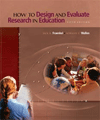Jack R. Fraenkel,
San Francisco State University
Norman E. Wallen,
San Francisco State University
| Alpha coefficient | see Cronbach alpha.
|
 |
 |
 |
| Concurrent validity | The degree to which the scores on an instrument are related to the scores on another instrument administered at the same time, or to some other criterion available at the same time.
|
 |
 |
 |
| Construct-related evidence of validity | The degree to which an instrument measures an intended hypothetical psychological construct, or nonobservable trait.
|
 |
 |
 |
| Content-related evidence of validity | The degree to which an instrument logically appears to measure an intended variable; it is determined to expert judgment.
|
 |
 |
 |
| Correlation coefficient | A decimal number between .00 and +1.00 and –1.00 that indicates the degree to which two quantitative variables are related.
|
 |
 |
 |
| Criterion-related evidence of validity | The degree to which performance on an instrument is related to performance on other instruments intended to measure the same variable, or to other variables logically related to the variable being measured.
|
 |
 |
 |
| Cronbach alpha | An internal consistency or reliability coefficient for an instrument requiring only one test administration.
|
 |
 |
 |
| Equivalent-forms method | A method to obtain to reliability coefficient; a way of checking consistency by correlating scores on equivalent forms of an instrument. It is also referred to as alternate-forms reliability.
|
 |
 |
 |
| Errors of measurement | Inconsistency of individual scores on the same instrument.
|
 |
 |
 |
| Expectancy table | A table used to analyze data obtained from a categorical variable and a criterion that is categorical.
|
 |
 |
 |
| Internal-consistency methods | Procedures for estimating reliability of scores using only one administration of the instrument.
|
 |
 |
 |
| Predictive validity | The degree to which scores on an instrument predict characteristics of individuals in a future situation.
|
 |
 |
 |
| Reliability | The degree to which scores obtained with an instrument are consistent measures of whatever the instrument measures.
|
 |
 |
 |
| Reliability coefficient | An index of the consistency of scores on the same instrument. There are several methods of computing a reliability coefficient, depending on the type of consistency and characteristics of the instrument.
|
 |
 |
 |
| Split-half procedure | A method of estimating the internal-consistency reliability of an instrument; it is obtained by giving an instrument once but scoring it twice – for each of two equivalent "half tests." These scores are then correlated.
|
 |
 |
 |
| Standard error of measurement | An estimate of the size of the error that one can expect in an individual's score
|
 |
 |
 |
| Test-retest method | A procedure for determining the extent to which scores from an instrument are reliable over time by correlating the scores from two administrations of the same instrument to the same individuals.
|
 |
 |
 |
| Validity | The degree to which correct inferences can be made based on results from an instrument; depends not only on the instrument itself, but also on the instrumentation process and the characteristics of the group studied.
|
 |
 |
 |
| Validity coefficient | An index of the validity of scores; a special application of the correlation coefficient.
|



 2003 McGraw-Hill Higher Education
2003 McGraw-Hill Higher Education